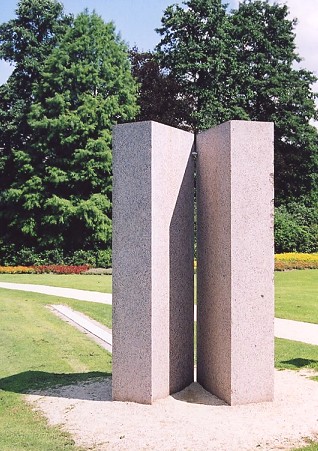
Sundial Park Genk
5. Euro meridian

Two granite blocks, 3 meter (10 ft) high and 5 ton in weight, enclose a slit of 3 cm wide (1.2"). It can pass a thin line of sunlight. When the sun is due south, at local noon, the light hits the center line of the tile plateau.
A small rod connects the two blocks, just below the top. It causes a break in the line of light. This break serves as a marker which indicates the date along the meridian line. The dates of the national holidays of the member states of the European Union are marked by crosslines and identified by the national flags.
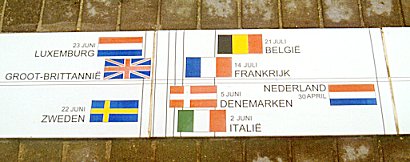
The sundial has been designed by Jan De Graeve, Vice President of the Flemish Sundial Society and project manager of the Sundial Park project. The tiles have been created by ceramics artist Jeanne Opgenhaffen (Belgium).
My comments:
Meridian lines
This is an interesting variation on the classical meridian line, sometimes found in cathedrals and other buildings. A small hole somewhere up the wall projects an image of the sun disk on the cathedral floor. The meridian line, often a copper strip inlaid in the floor tiles, runs due north from the foot point of the aperture. When the sun spot crosses the meridian line, it's noon. A date scale or zodiac scale is often laid out along the line, or at least the points for the equinox and the solstices are marked.
Well-known examples are:
In the past, meridian lines were used to establish the date of Easter. Here, it indicates more profane feasts: the national holidays of the member states of the European Union in 1999. Details can be found below.
The gnomon: a slit
The 0.5° angle of the solar disk will cause the line of light to broaden and get dimmer at larger distances from the slit. The figure below is a schematic illustration of this effect. The distance at which the intensity starts to drop depends on the declination of the sun. At the summer equinox it is about 1.6 m (over 5 ft), in winter 3.3 m (11 ft) from the bottom of the slit.

The granite blocks are 1.0 x 0.5 m (1.6 x 3.2 ft) wide. The wide side of the eastern block is oriented north-south, the azimuth of the western block is 48°. Hence, sunlight falls through the slit from just before local noon until the sun's azimuth is 48°. That is at about 13:50 hr (local time) around the summer solstice, but in winter at about 15:35 hr.
The granite is polished. As a consequence, the reflection against the west face of the eastern block causes a second line of light, which moves across the meridian line in opposite direction. The photo below shows this effect just after noon.
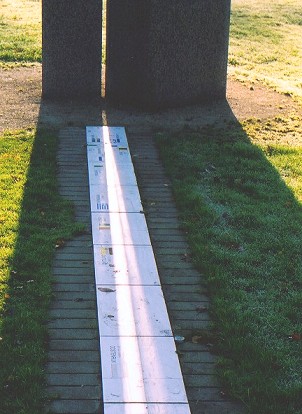
The index marks the date
The rod is 4 cm (1.6") thick and is fixed at a height of 2.75 m (9 ft). At the summer solstice the shadow will fall about 1.4 m (almost 5 ft) from the foot point of the slit, at the winter solstice about 9.8 m (32 ft) out. The tile plateau stretches 10 meter to the north, just long enough. The picture below shows the shadow of the index shortly after noon on 17 July 2001. Note the fading of the red glazing in the Danish flag.
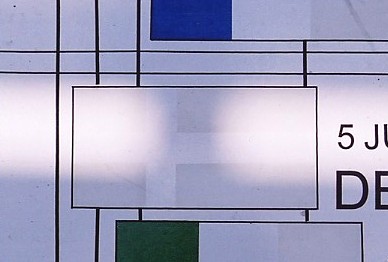
An aperture high up a cathedral wall may yield a relatively sharp image of the sun (principle of the pin-hole camera): the size of the image increases with the distance, whereas the width of the fuzzy edge remains about equal to the size of the hole. In contrast, the shadow of a small object like the rod gets fuzzier at larger distances. Beyond a certain distance, the penumbra will have 'eaten' the shadow. This point lies at about 3.75 m (12 ft) from the bottom of the slit.
Meridian transit and daylength
The brochure states: "The meridian transit is an instant of astronomical importance that is measured even today in all observatories to record the motions of the earth and incorporate these into civil timekeeping." That was indeed the case until 40 years ago. Each observatory had a meridian instrument to time the transit of stars by hand. Today the motions of the earth are monitored by more advanced techniques, such as Very Long Baseline Radio Interferometry.
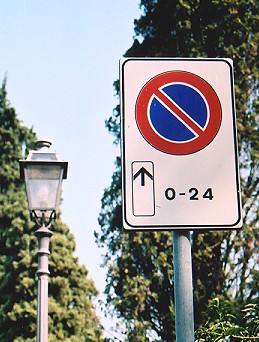 A.m. and p.m.
A.m. and p.m.
The importance of the meridian transit is still found in the Anglo-American usage of a.m. (ante meridiem) and p.m. (post meridiem) for the parts of the day before or after noon. This contrasts with the usage in other countries, where time runs from 0:00 to 24:00 hr, the latter being identical to 0:00 hr of the following day. This is compact and unequivocal. The picture illustrates this usage on a road sign.
As our personal computers adopted the American hour counting habits, I should dwell briefly upon its peculiarities.
National holidays
 The reason why the EU countries are remembered here, is rather obvious: the European Union gave generous financial support to the project. What to do with the 10 countries that will join in 2004? Once again politics and sundials appear not to go along very well. Remember the end of summertime (daylight saving time), which in 1996 was moved from the end of September to the end of October by the EU, so that at many sundials the instructions to correct for summertime were at once incorrect.
The reason why the EU countries are remembered here, is rather obvious: the European Union gave generous financial support to the project. What to do with the 10 countries that will join in 2004? Once again politics and sundials appear not to go along very well. Remember the end of summertime (daylight saving time), which in 1996 was moved from the end of September to the end of October by the EU, so that at many sundials the instructions to correct for summertime were at once incorrect.
On the other hand, it would be good to renew the tile plateau. The colors of the national flags, especially red, have faded considerably, as can be seen below. The picture at the left dates from July 2000, the first summer, the right-hand one was taken one year later.
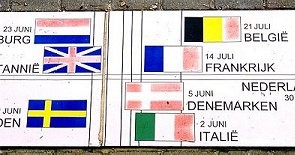 |
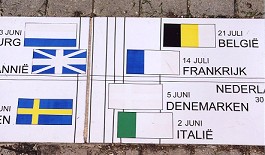 |
What are national holidays anyway? Those specified in the national legislations? Some countries don't have one, others have several. The Netherlands, for instance, has two official national holidays: the Queen's Birthday (30 April) and Libaration Day (5 May). The first one is being celebrated rather enthousiastically, the second one is more often used to catch up with overdue garden maintenance. The dates recorded here have been provided by the EU Bureau.
But what is being celebrated on these days? An internet search resulted in the table below. Great Britain is a special case. It has a date line and the Union Jack glazed here, but no date is given. It could be around 10 June or 3 July. I have opted for the first one, and linked it to the Trooping the Colour ceremony, which is usually being held on the second or third Saturday in June.
National holidays of the EU countries (1999)
| Country | Flag | Date | Holiday | Origin |
| Austria | 26 Oct | National Holiday |
1955: neutrality law passed; allied occupation ends | |
| Belgium | 21 Jul | Constitution Day |
1831: King Leopold I takes oath on the constitution | |
| Denmark | 5 Jun | Constitution Day |
1849: King Frederik VII signs the constitution | |
| Finland | 6 Dec | Independence Day |
1917: independence from Russia | |
| France | 14 Jul | French Revolution |
1789: siege of the Bastille | |
| Germany | 3 Oct | Day of the German Unity |
1990: West and East Germany reunified | |
| Greece | 25 Mar | Independence Day |
revolution of 1821, Turkish occupation ends | |
| Great Britain | 10 Jun? | Trooping the Colour? |
since 1748, usually on 2nd or 3rd Saturday in June | |
| Ireland | 17 Mar | St. Patrick's Day |
patron Saint of Ireland (ca. 385-461) | |
| Italy | 2 Jun | Institution of the Republic |
1946: monarchy abolished | |
| Luxemburg | 23 Jun | Grand-Duke's Day |
this date since 1961 because of the weather; Louis, the present Grand Duke, was born on 16 April | |
| Netherlands | 30 Apr | Queen's Day | birthday of former queen Juliana; Beatrix, the present queen, was born on 31 January | |
| Portugal | 25 Apr | Liberation Day |
revolution of 1974; dictatorship overturned | |
| Spain | 6 Dec | Constitution Day |
1978: parliamentary democracy established | |
| Sweden | 22 Jun | Midsummer Day |
- |